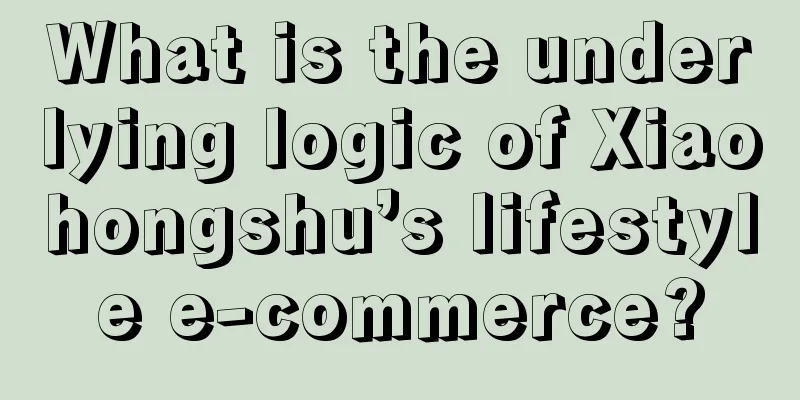What is the underlying logic of Xiaohongshu’s lifestyle e-commerce?

The ultimate mission of lifestyle e-commerce is ALTV. A few days ago, my mother complained that the newly bought shampoo did not produce enough foam and could not clean her hair thoroughly. I asked her what brand she wanted and where she bought it. She said Head & Shoulders. She bought it online. I took it and looked at it, and it clearly said "Waterfly". Although I knew I was being cheated, I was not in a hurry: "It's okay, I can just get a refund." The matter seems to be resolved, but I feel a little sad. Yes, this is realistic for 2024. The e-commerce world has become so crowded that major platforms have put the user experience first. However, this nominal attempt to please users ends up hurting them. This suddenly made me realize that although e-commerce has been active for nearly 20 years, platforms and merchants have never truly understood users and paid attention to the underlying logic of consumption. Do consumers want to return products and get refunds? Consumers want to buy satisfactory products and add a touch of color to their lives. The bottom-line price competition will only bring us low-quality oversupply and extremely poor consumer experience. On the other hand, the marginal benefits of e-commerce platforms as a tool to stimulate consumption growth are decreasing, and the survival environment of brand companies is under infinite pressure. Over the past year or so, I have visited many businesses and met with many brand managers. There is a question I often ask: how can we achieve high average order value and low return rate? These two have become the pain points of current e-commerce. Regarding high order values, I need to explain that the focus is not on how to sell the product at a price far higher than the product itself, but on selling it at the price it deserves, which is becoming increasingly difficult nowadays. In these surveys, I often hear Xiaohongshu mentioned. In the eyes of these brand managers, on Xiaohongshu, you don’t need to desperately try to increase the price, and you don’t need to use exaggerated words and emotional story scripts. As long as you clearly explain the material, color, design, and the use experience and scenarios in life, you will get good orders. A furniture manager said that his products with a relatively high average order value sold well on Xiaohongshu, but according to the logic of low-priced hot-selling products, the sofas he made did not sell as well as expected. When analyzing the reasons, she said that for these decision-making products that are often used in life, when Xiaohongshu users buy them, in addition to the product itself, the person behind it is very important. Your opinions, your ideas, your aesthetics, and the way you use it in life, whether it can resonate with consumers are what they care about. On Xiaohongshu, lifestyle is more important than business, and "quality-price ratio" is more important than pure low price. With these surveys, I have a different feeling about the conversation between Xiaohongshu COO Conan and economist Xue Zhaofeng a few days ago. It was in this conversation video that Conan first defined Xiaohongshu e-commerce as "lifestyle e-commerce", which allows users to buy not only good products on Xiaohongshu, but also a desirable life. Conan said that the key to lifestyle e-commerce is to activate the power of people in the e-commerce field to create purchasing scenarios close to life and meet users' personalized needs. This coincides with some of the information I obtained from previous research. Therefore, in this article, I try to break down the underlying logic of lifestyle e-commerce and how to truly do lifestyle e-commerce well. 1. A city where life is more important than consumptionSome people often say that declining purchasing power is the “culprit” for the difficulty of sustainable growth. But I don’t agree. "Purchasing power" is an abstract quantification of a person's consumption behavior. The term itself is full of offense to consumers. In his annual speech, Lei Jun talked about how to build a car and said "one hundred (research) Do you really treat consumers as the people you want to serve? In an era of consumerism, platforms and merchants use consumer propositions to sell goods, but most operators ignore the essence of consumption. Christensen, the author of The Innovator's Dilemma, pointed out in his other book, Competing with Luck, that "consumers buy goods to complete tasks in specific life scenarios and to achieve progress in life." Therefore, consumption is only a means, and life is the goal. This may reveal why Xiaohongshu chose "lifestyle" as its entry point for e-commerce. In fact, neither Jobs nor Akio Morita liked market research. In their view, questionnaires and data can be used as a basis for user insights, but they are by no means the final word, because they may not accurately and clearly reflect the motivations of user consumption behavior. When the whirlwind of consumerism has passed, the stage of rational consumption has arrived, and the characteristics of returning to the essence of consumption are particularly obvious. Each of us living in the city is a living person. To the community, city and society, people’s value is not just that of a consumer; their greater significance lies in life. If consumers do not make purchasing decisions, there is no service value, and consumers can only be regarded as the end point of the value chain. But life exists all the time. It is both the starting point and the end point. For example, the seven emotions and six desires are all part of life. Our lives are full of humanity. The reason why non-functional brands such as Pop Mart and Guan Xia Wen Xian can still emerge in the era of rational consumption is that everyone is pursuing emotional expression, being true to themselves and enjoying life, which will highlight the importance of emotional value. We often ask, do people buy Dyson just to blow dry their hair? Do they wear jackets to go hiking? They will try different lifestyles and find people who share similar aesthetic values. Therefore, these products or brands are consumer products with added value. I remember that a long time ago, the founding team of Xiaohongshu compared Xiaohongshu to a city. In my opinion, a city is not only a shopping terminal. Its mission is to enable every individual to become a creator of lifestyle in the process of expressing themselves and accepting others. Therefore, when operating in a city like this, people are the most important. For example, food, clothing, housing and transportation are all part of life. Our lives are full of continuity. However, in the modern business world, platforms and businesses are keen to label and fragment users. Businesses often complain that consumers are "scumbags" - they don't take the initiative, don't refuse, don't take responsibility, and don't remember. However, getting tired of the old and liking the new has never been a characteristic of the times, but human nature itself. People are constantly growing and evolving in their interactions with society. In the ever-changing consumer behavior, if we ignore the continuity of people, we cannot truly understand a consumer. To grasp the core of a consumer, we need to view the consumer's life in a coherent way. Therefore, those who live on Xiaohongshu do not share the present moment, but every moment. This person may be a food blogger, a fitness expert, or a fan of Xiao Zhan and Wang Yibo. The notes accumulated over the years are a reflection of the continuity of life on Xiaohongshu. Therefore, I often say that the brands on Xiaohongshu are "cultivation systems" rather than "ripening systems". For example, no matter where you are, it’s all about life. Our lives are full of choices. Freedom is to follow your heart, not to follow the crowd. However, the marketing rhetoric and brainwashing strategies of platforms and merchants are always trying to "hard-control" consumers. Massive marketing investment is like "hallucinogens", which can exchange for consumers' short-term attention, but cannot fundamentally shape consumers' loyalty to brands and merchants. The repetitive and monotonous output of hot products may even cause consumption to follow the trend and become seriously homogenized. When people get used to it and even think it should be this way, some live broadcasts by managers on Xiaohongshu often emerge with their own style and ideas. Caption: The Xiaohongshu live broadcast room of the women's shoe brand "SONDER PLAN": a pair of leather shoes is under the spotlight in the middle of the picture, with no fancy background and no sales urging. 2. Life is self-realization with experience at its coreSome people may be curious: Why do we need lifestyle e-commerce? Aren’t there already shelf e-commerce and content e-commerce? But I think the e-commerce model has never been fixed or bounded. From the perspective of consumers, when we shop, do we prioritize shelf e-commerce or content e-commerce? We only choose the purchase scenario based on our own needs. Therefore, I prefer to divide consumption into "planned consumption" and "impulsive consumption". As the name suggests, planned consumption has clear purchasing goals. Consumers first generate needs and then clarify solutions (category/product/service) This is what we often call "people looking for goods". Planned consumption uses search as the main behavior and underlying technology. Therefore, search optimization and search advertising are the core skills that merchants must master in the past. When the Internet was first created, there was a shortage of users and goods, so the underlying logic for its rapid growth was the demographic dividend of the first batch of Internet users. But when e-commerce entered its mature stage, online supply suddenly exploded, and search results began to become redundant and complex. This was accompanied by a decline in consumer shopping efficiency. Impulsive consumption did not emerge after planned consumption failed, but rather personalized recommendation technology gave the former more room to play. Whether it is social e-commerce or live streaming, both push a single product directly to consumers, solving the efficiency problem of having to screen again from numerous search results. The essence of both is "goods find people". The advantage of impulse buying is that it taps into consumers’ potential needs and stimulates unplanned consumption desires. But the corresponding problem is that influencers’ “salesman-like” promotional posture and sales methods that force orders often make consumers feel oppressed. Is there no other choice besides planned consumption and impulsive consumption? Some brand managers told me that future consumption may be experiential consumption. They made a subtle metaphor: if planned consumption is shopping in the supermarket, and impulsive consumption is watching TV and listening to the radio, then experiential consumption is feeling life in a city. They even convinced me from the UI interaction. "Browsing" Douyin and "browsing" Xiaohongshu - this action has already hinted to us: browsing is the core of Xiaohongshu. Yes. Wandering around a city on a "CityWalk" is a free and uninterrupted route. Live first, consume later. Follow the laws of nature. To use the words of Xiaohongshu COO Conan, the "people" in lifestyle e-commerce must be those who can truly create combinations and select products based on user needs. And these people can bring value and lifestyle experience to users beyond price. I thought about it carefully. Indeed, modern humans are not only satisfied with physiological safety needs, but their ultimate goal is self-realization. The essence of experiential consumption is self-realization. In the process of self-realization, respecting true understanding becomes three new feelings of consumers as independent individuals. The general direction of Xiaohongshu e-commerce is to integrate with the community. The interactive design of the "double-column feed flow" of the Xiaohongshu community gives users freedom and choice, and users are more likely to think that they are respected. Therefore, consumers' shopping experience on Xiaohongshu is to pursue a sense of relaxation and self-pleasure, and also to seek the fun of exploration. Positioned as a lifestyle content sharing platform, Xiaohongshu's content is less exaggerated and more of a humanized expression of real life. These managers and buyers, rooted in Xiaohongshu, show their professionalism, break the routine and treat people sincerely, becoming a powerful tool for attracting fans. I saw a merchant on Xiaohongshu, "Yinuo Bennuo" in the jewelry industry. From resisting live broadcasting to achieving an average monthly GMV of 3 million and a single GMV of 1 million in the brand live broadcast room, the secret is to talk about the product with a "buyer's mindset". "Users on Xiaohongshu are willing to tolerate your truest side. So from the first live broadcast, I always explained the product with the most sincere attitude. Surprisingly, this method can still attract a group of people to listen." In addition, the hosts on Xiaohongshu will better understand the personalized and diversified needs of users. In the process of communicating with them, you will find that each of them is operating a business in a certain group of people, an experience, or a scenario. The value of being a "10-meter wide and 100-meter deep" track is greater than being a "100-meter wide and 10-meter deep". Life is inherently diverse, and the user needs that arise from life must also be diverse and personalized. According to Conan, more and more businesses are doing business based on increasingly segmented demands, and "small demands can also lead to good business." 3. The ultimate mission of lifestyle e-commerce is ALTVLifestyle e-commerce should not be a concept. The best way to realize it is to find the North Star indicator for operating Xiaohongshu e-commerce. In fact, in every business era, there is a key indicator that can guide businesses. For example, the value of a traditional e-commerce platform is measured by GMV, and the key indicator is the monetization value of traffic (UV). When it comes to live streaming e-commerce, GPM is the key indicator, and the monetization value of exposure has become the key indicator. I think that for lifestyle e-commerce, what needs to be considered is ALTV (total customer lifetime value). The average order value, repurchase rate and recommendation rate have become key indicators. Why does lifestyle e-commerce need to emphasize user life cycle? As mentioned above, if you realize that "life is more important than consumption", you will understand that consumption is the end point, while life is the whole process from beginning to end. Caring for and responding to the needs of each user at different stages of Xiaohongshu is the greatest business achievement that brand companies should achieve. The people who can really do a good job in lifestyle e-commerce are not traditional store owners or traffic operators, but the people who manage their own lives. Therefore, Gintoki, the head of e-commerce operations at Xiaohongshu, said, "To do a good job in lifestyle e-commerce, the people behind the scenes are very important." For example, how can we establish a good starting point for brand management in lifestyle e-commerce? Lifestyle e-commerce is not only a channel to reach new groups of people, but also a "greenhouse" for cultivating consumers' brand awareness from scratch, from seeing to buying, and from buying to advocacy. If Xiaohongshu is a city, then the live broadcast room is the business owner’s presence in this city (community). In the live broadcast room, the brand manager does not need to talk about rhetoric, low prices or decoration. The only thing he needs to do is to introduce the product selling points, provide solutions in life, and inspire users' yearning for a better life. In the opinion of the founder of the home furnishing brand OKENSHO, home furnishings are products that are highly related to "people". Based on this, communication with "people", that is, users, is very important to OKENSHO. Since its launch, OKENSHO has always insisted on daily broadcasts and encouraged anchors to "forget" data during the live broadcast, explain the product clearly, connect with users, and make reasonable transactions. As a result, OKENSHO ushered in an explosion in 618 this year, with a single GMV breakthrough of one million. Note: OKENSHO brand live broadcast room For example, how to form an anchor point for brand management? When doing e-commerce on Xiaohongshu, live streaming is not for the sake of live streaming. The ultimate goal is to make core users pay attention to the owner and remember the brand. Therefore, in addition to the live broadcast room, Xiaohongshu also has accounts and notes. The integrated operation strategy of account and live broadcast can more completely display the life traces of the owner, and can also show the multifaceted nature of a brand in a more three-dimensional way. A fashion brand manager named "Zhou Qi CHOWKI" on Xiaohongshu can create 40 matching plans for a pair of pants in her live broadcast room, meeting the matching needs of different people in different scenarios. She said that her core skill is "one piece of clothing in multiple ways". On weekdays, the account will present different styles and lifestyles of one piece of clothing in multiple ways through videos, and three live broadcasts every week will combine life scenes to share her dressing ideas. She said that users know their own aesthetics, and she understands their needs, and the collision between them triggers resonance. As the connection with consumers on Xiaohongshu deepens, fans will become more and more accurate, and products will also become more and more accurate. " Another example is how to find the focus of brand management. The process of operating a lifestyle e-commerce is also a process in which brand managers grow with users and co-create with them. Every brand manager expects users to follow him/her from beginning to end. Therefore, expanding the private domain has become a business consensus of all brands. This is in line with Xiaohongshu's encouragement of the development of private domain group chats. OKENSHO regards group chat as a "secondary stimulation" between products and consumers. After the notes are planted, OKENSHO welcomes consumers to criticize the products in the group chat, and then clarify the style matching. Through multiple touches, not only can the content traffic be converted into crowd assets and mental assets, but it can also influence brand decisions. Any brand must go through the development stages from small to large, from slow to fast, and from weak to strong. The changes in the consumer environment must make each of us brand managers realize that "longer than the length and quality of life" is the survival consensus of the current consumer market. And crossing the life cycle of consumers is crossing the life cycle of brands. Today, when facing any e-commerce ecosystem, we must first recognize and understand it, rather than blindly follow it. When building a brand, should we accelerate its development or nurture it? The essence of this lies in whether we have found the underlying logic of the business environment. Today, I see that the underlying logic of a lifestyle e-commerce is taking shape: the community is the foundation, the experience is the traction, and the user life cycle is the core value. This is exactly what the prosperous e-commerce ecosystem should look like after evolution. Author: Jaquin Source: WeChat public account "Yibang Power" |
<<: A guide to riding on the popularity of Xiaohongshu
>>: Overlord Tea Princess, step on the accelerator
Recommend
Creating a hot-selling product: creating a trend or chasing a trend
For companies that sell products, a hit product me...
What is the normal payment period for cross-border e-commerce? How long does it take to get paid?
With the progress of global economic integration, ...
Fun = Gold: How to Make Money from Brand Marketing in the Emotional Age
A few days ago, I attended the 2024 "Talk Abo...
How much is the sales revenue of a cross-border e-commerce company? How to make good sales?
The sales revenue of cross-border e-commerce compa...
Marketers' business thinking
In the workplace, having a say will bring you a be...
What are the cross-border e-commerce b2b platforms? Are there many choices?
Cross-border e-commerce platforms have always been...
In-depth analysis of the application skills of "anchoring effect" in marketing
The "anchoring effect" is a very famous ...
Business analysis, how to diagnose business problems
This article starts from the business diagnosis of...
Is it good to have only one product in cross-border e-commerce? How to list products?
In the cross-border e-commerce industry, choosing ...
How many days can Shopee's vacation mode last? How to enable vacation mode?
Nowadays, many people are engaged in cross-border ...
Cat memes dominate the charts on three platforms, hitting three key elements of a hit
This article deeply analyzes the phenomenon of cat...
eBay Australia to reduce Orange Connex delivery fees
eBay Australia recently announced that before Janu...
Targeting 600 million users, Taobao returns to PC, just because of what Jack Ma said?
After seven years, Taobao has made a major update ...
Rebirth: New opportunities for small and medium-sized businesses on Xiaohongshu
This article analyzes the marketing cases of Xiaoh...
What is the difference between advertising and content?
This article specifically introduces the relations...









